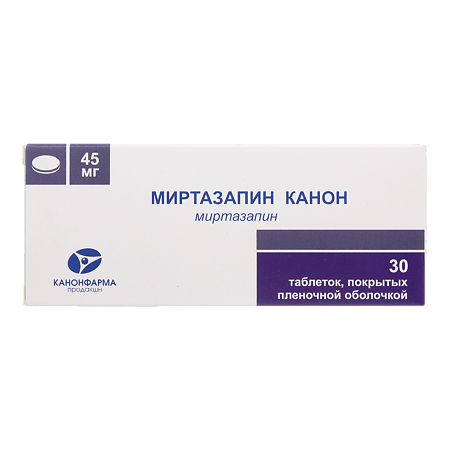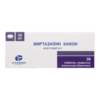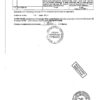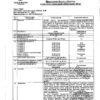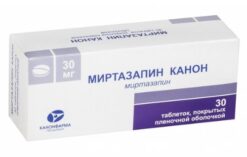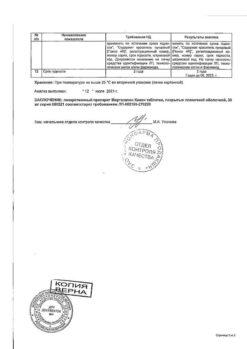No products in the cart.
Mirtazapine Canon, 45 mg 30 pcs
€33.81 €28.17
Description
A tetracycline antidepressant. Enhances central adrenergic and serotonergic transmission. It blocks serotonin 5-HT2- and 5-HT3-receptors, in connection with this strengthening of serotonergic transmission is realized only through serotonin 5-HT1-receptors. Both spatial enantiomers are involved in the antidepressant activity: S(+)-enantiomer blocks α2-adrenoceptors and serotonin 5-HT2-receptors. Moderately blocks histamine H1-receptors, has a sedative effect.
Little effect on α1-adrenoreceptors and cholinoreceptors; in therapeutic doses has no significant effect on the cardiovascular system.
In clinical conditions, anxiolytic and hypnotic effects are also seen, which is why mirtazapine is most effective for anxiety depressions of different genesis. Because of moderate sedative action during treatment it does not actualize suicidal thoughts.
Pharmacokinetics
Mirtazapine is rapidly absorbed from the gastrointestinal tract after oral administration. Bioavailability is 50%. Cmax in plasma is reached after 2 hours.
The Css in plasma is established after 3-4 days of continuous administration. Binding to plasma proteins is 85%.
It is actively metabolized in the liver by demethylation and oxidation followed by conjugation. Dimethyl-mirtazapine is as pharmacologically active as the parent substance.
Mirtazapine is excreted by the kidneys and through the intestine. The T1/2 is 20-40 hrs.
In renal and hepatic insufficiency, the clearance of mirtazapine may be decreased.
Indications
Indications
Depressive states (including anhedonia, psychomotor retardation, insomnia, early awakening, weight loss, loss of interest in life, suicidal thoughts and mood lability).
Pharmacological effect
Pharmacological effect
Antidepressant with tetracyclic structure. Strengthens central adrenergic and serotonergic transmission. It blocks serotonin 5-HT2 and 5-HT3 receptors; therefore, the enhancement of serotonergic transmission is realized only through serotonin 5-HT1 receptors. Both spatial enantiomers are involved in the manifestation of antidepressant activity: the S(+) enantiomer blocks α2-adrenergic receptors and serotonin 5-HT2 receptors. Moderately blocks histamine H1 receptors and has a sedative effect.
Has little effect on α1-adrenergic receptors and cholinergic receptors; in therapeutic doses does not have a significant effect on the cardiovascular system.
In clinical conditions, anxiolytic and hypnotic effects are also manifested, therefore mirtazapine is most effective for anxious depression of various origins. Due to the moderate sedative effect, it does not actualize suicidal thoughts during the treatment process.
Pharmacokinetics
Mirtazapine after oral administration is rapidly absorbed from the gastrointestinal tract. Bioavailability is 50%. Cmax in blood plasma is reached after 2 hours.
Css in blood plasma is established after 3-4 days of continuous use. Plasma protein binding is 85%.
Actively metabolized in the liver by demethylation and oxidation followed by conjugation. Dimethylmirtazapine is as pharmacologically active as the parent substance.
Mirtazapine is excreted by the kidneys and intestines. T1/2 is 20-40 hours.
In case of renal and hepatic failure, the clearance of mirtazapine may be reduced.
Special instructions
Special instructions
Use with caution in patients with epilepsy and organic brain damage, impaired liver and/or kidney function, acute cardiovascular diseases, arterial hypotension, urinary disorders caused by benign prostatic hyperplasia, angle-closure glaucoma, and diabetes mellitus.
In patients with schizophrenia, mirtazapine may cause increased delusions and hallucinations. When treating the depressive phase of manic-depressive psychosis, this condition can develop into a manic phase.
Sudden cessation of mirtazapine after long-term treatment may cause nausea, headache, and poor health.
It should be borne in mind that if symptoms such as fever, sore throat, or stomatitis appear during treatment, treatment should be stopped and a clinical blood test done.
If jaundice occurs, mirtazapine should be discontinued.
Should not be used simultaneously with MAO inhibitors and within 2 weeks after their discontinuation.
It is possible to develop drug dependence and withdrawal syndrome.
During treatment, patients should refrain from drinking alcohol.
Mirtazapine is not used in children due to the lack of data on the effectiveness and safety of its use in pediatric practice.
Impact on the ability to drive vehicles and operate machinery
Use with caution in patients whose activities require a high concentration of attention and speed of psychomotor reactions.
Active ingredient
Active ingredient
Mirtazapine
Composition
Composition
Mirtazapine – 45 mg.
Contraindications
Contraindications
Renal and liver failure, pregnancy, lactation, hypersensitivity to mirtazapine.
Side Effects
Side Effects
In a 6-week controlled trial, approximately 16% of 453 patients receiving mirtazapine discontinued treatment due to side effects, compared with 7% of 361 patients receiving placebo. Adverse effects observed in ≥1% of patients associated with treatment discontinuation and considered to be attributable to mirtazapine (i.e., occurring at least 2 times more frequently with mirtazapine compared to placebo) included the following: drowsiness 10.4% (2.2%), nausea 1.5% (0%).
The following are side effects that were observed in short-term (6 weeks) placebo-controlled trials in 1% or more cases and were more frequent than in the placebo group (% incidence in the placebo group is indicated in parentheses). It should be borne in mind that these data cannot be used to predict the occurrence of side effects in routine medical practice, because patient conditions and other factors differ from those that prevailed in clinical trials. The reported incidence of side effects may differ from those obtained by other clinical researchers, but they can provide the clinician with information about the relative contribution of the substance itself and other factors (not related to the drug) to the development of side effects in the population being studied.
From the nervous system and sensory organs: drowsiness 54% (18%), asthenia 8% (5%), dizziness 7% (3%), unusual dreams 4% (1%), disturbance of the thinking process 3% (1%), tremor 2% (1%), confusion 2% (0%).
From the gastrointestinal tract: dry mouth 25% (15%), increased appetite 17% (2%), constipation 13% (7%).
Other: weight gain 12% (2%), flu-like syndrome 5% (3%), back pain 2% (1%), myalgia 2% (1%), increased urination 2% (1%), peripheral edema 2% (1%), dyspnea 1% (0%).
Adverse effects noted in these clinical trials in at least 1% of patients receiving mirtazapine and observed less frequently than in the placebo group: headache, infection, chest pain, palpitations, tachycardia, orthostatic hypotension, nausea, dyspepsia, diarrhea, flatulence, decreased libido, hypertension, pharyngitis, rhinitis, sweating, amblyopia, tinnitus, taste perversion.
Interaction
Interaction
With simultaneous use, mirtazapine enhances the sedative effect of benzodiazepine derivatives.
A case of the development of a hypertensive crisis with simultaneous use with clonidine has been described.
When used simultaneously with levodopa, a case of severe psychosis has been described; with sertraline – a case of hypomania.
When used simultaneously with ethanol, the inhibitory effect of ethanol and ethanol-containing drugs on the central nervous system may be enhanced.
Overdose
Overdose
In a dry place, protected from light, at a temperature not exceeding 25 °C.
Keep out of the reach of children.
Storage conditions
Storage conditions
2 years.
Manufacturer
Manufacturer
Kanonpharma production CJSC, Russia
Additional information
| Manufacturer | Kanonfarma Production ZAO, Russia |
|---|---|
| Medication form | pills |
| Brand | Kanonfarma Production ZAO |
Other forms…
Related products
Buy Mirtazapine Canon, 45 mg 30 pcs with delivery to USA, UK, Europe and over 120 other countries.

